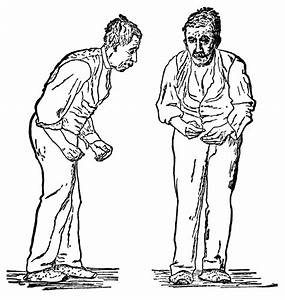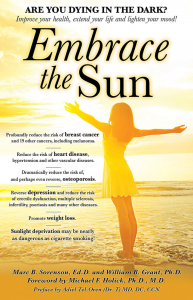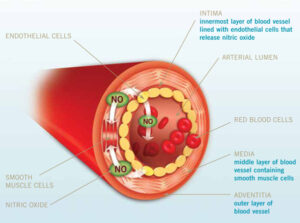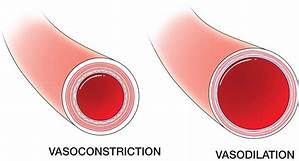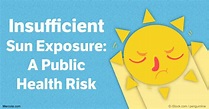Vitamin D power for immunity and Covid-19 by Marc Sorenson EdD
Vitamin D power may be exactly what we need to defeat covid-19 and other maladies. This is a according to a press release and new research from the Vitamin D Society of Canada (VDSC). The release is entitled Strengthen Your Immune System to fight COVID-19 – World Vitamin D Day. It indicates optimal vitamin D levels may equal social distancing and masks for reducing covid-19 this winter. VDSC Executive Director Perry Holman states, “Increasing your daily intake of vitamin D is an action you can take immediately to safeguard your health until a COVID-19 vaccine becomes available. Many people have deficient or insufficient vitamin D levels. As we celebrate the 11th anniversary of World Vitamin D Day on Nov. 2, please evaluate your vitamin D intake and increase it to COVID-19 fighting levels.”
The press release then discusses how to increase vitamin D.
Adults should take 4,000 IU per day of vitamin D. Thus, Dr. Anthony Fauci, a leading infectious disease expert, takes 6,000 IU per day.
Enjoy natural sunlight when the UV index reaches three and your shadow is shorter than you are. Never sunburn. (This, in my opinion, is the most important and natural way to produce vitamin D power.)
Consider artificial UVB exposure when natural sunlight is weak or not available and your skin type can receive UV exposure without burning.
Increase your food intake of fatty fish such as salmon.
Take a vitamin D3 supplement to make up the balance when sun exposure is not available. UVB from sunlight or a sunlamp is what makes vitamin D naturally in your skin.
New research backs up the press release and lends credence to the focus of the article. The research below is verbatim from the press release and shows the efficacy of vitamin D .
In a US based study of over 190,000 people, researchers found that those people with a deficient vitamin D blood level (below 50 nmol/L or 20 mg/ml) had a 54% higher COVID-19 positivity rate compared with people who had adequate vitamin D levels (75 nmol/L or 30 ng/ml). (Kaufman 2020)
In a study published in the Journal of the American Medical Association (JAMA), researchers at the University of Chicago found that patients who had deficient vitamin D blood level (less than 50 nmol/L or 20 ng/ml) had a 77% greater risk of testing positive for COVID-19 vs patients who had a sufficient vitamin D status. (Meltzer 2020)
A small, randomized controlled trial (RCT) study in Spain found that COVID-19 patients treated with vitamin D were less likely to be admitted to the intensive care unit (ICU) and less likely to die from COVID-19. The study found that 50% of the patients not receiving vitamin D were admitted to the ICU compared to 2% of the patients receiving vitamin D. Two out of 26 patients who did not receive vitamin D died while none of the 50 vitamin D treated patients died. Some hospitals in Spain are now moving their COVID-19 patients out in the sun to increase their vitamin D. (Castillo 2020)
An Israeli population-based study of 7,807 individuals found that people with vitamin D levels greater than 75 nmol/L or 30 ng/ml were 50% less likely to contract COVID-19 and 95% less likely to suffer hospital stays. (Merzon 2020).
In conclusion, the press release from the vitamin D Society holds the key to preventing Covid-19.
Remember, the very best method to raise vitamin D power is regular, non-burning sun exposure! 
Read the entire press release here.
Keep sunning and optimize your vitamin D power!
For more on vitamin D and sunlight, visit the Sunlight Institute and read the book, Embrace the Sun. 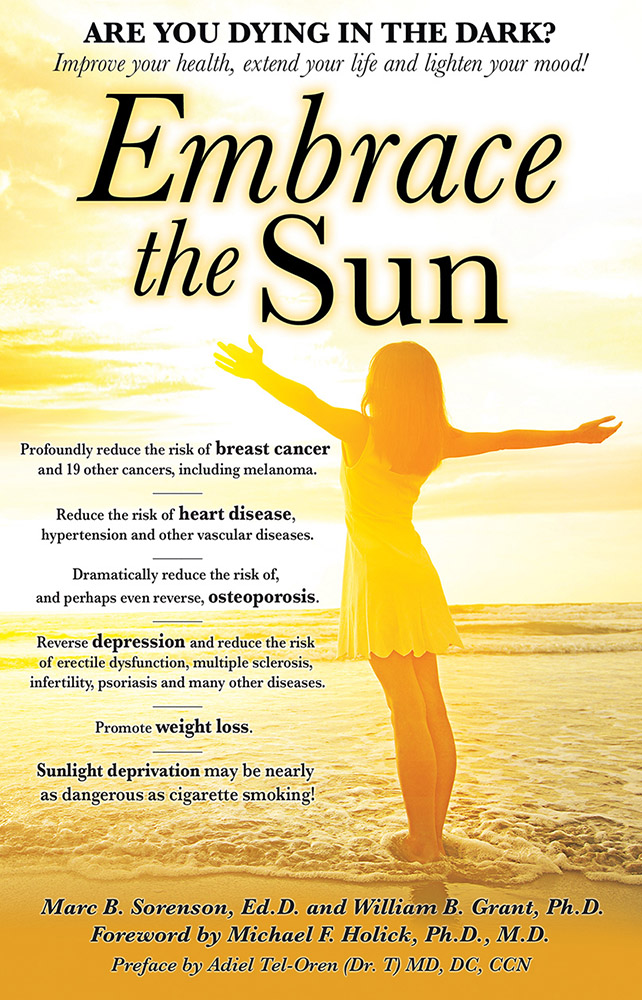
Sleeping soundly through sun exposure by Marc Sorenson, EdD.

Sleeping in vital to human function and insomnia (inability to sleep) is a major detriment to health. Consider the following facts: Most noteworthy, persons taking 18 sleeping pills yearly triple the risk of death, compared to those taking fewer than 18. Furthermore, an article from Forbes stated, “In 2012, 60 million Americans filled prescriptions for sleeping pills, up from 46 million in 2006.”
More information from Forbes regarding the need for sleep.
The Forbes article then described the results of recent research on sunlight and sleeping. It showed workers, whose workplaces have windows and other natural light sources, could sleep about 46 minutes per night more, compared to those who had no natural light access. In addition, those who had more sun showed greater happiness, had fewer ailments, and experienced better vitality. Thus, it follows that whatever the disorder causing insomnia, there is a better way of dealing with it. Therefore, frying the brain with pills should not be the method of choice to increase sleeping ability.
Vitamin D did not not associate with the aforementioned increased sleep.
This research is particularly interesting because the effects of sun exposure in this case probably had nothing to do with vitamin D, since the solar rays came through windows, which block the vitamin D-producing UVB light. It is likely that the positive effects of the sun occurred due to increasing serotonin levels (a natural mood enhancer) in the brain during sun exposure, and then by allowing melatonin (a natural relaxer) to take over during the night.
Sleeping, and the lack thereof, closely associate with several illnesses.
A study from Egypt reveals several factors associated with insomnia (inability to sleep) among elderly people: Having five or more chronic diseases associated to a 7.5 tmes increased insomnia risk; anxiety associated with a 1.9 times increased risk; and depression with a 1.7 times increased risk. Only one factor, sun exposure, associated with reduced insomnia risk—a 43% reduction! Likely, this was due to the sun-related production of serotonin and melatonin
It is becoming increasingly obvious that lack of sleep is a major risk factor for human health, as reported in the journal Sleep Medicine, regarding metabolic syndrome (Met S). Met S is a group of metabolic disorders (high blood pressure, abdominal obesity, high cholesterol, high triglyceride levels, low HDL levels and insulin resistance). In addition, it associates to increased risk of cardiovascular disease and type 2 diabetes. The study assessed 2579 adults without Met S for sleep habits during a 2.6-year period. This determined their risk of developing the Met S. The participants’ age ranged between 40 and 70 years.
The results
Those who slept 6 hours or less were 41% more likely to develop Met S, compared to those who slept 6-8 hours. High blood glucose and excess belly fat increased by 30%. Both of these predict future diabetes. In addition a 56% increase in high blood pressure risk occurred. The researchers concluded: “Short sleep duration is an independent risk factor for incident metabolic syndrome in a population-based longitudinal study.”
Sleep deprivation is a common and perhaps deadly malady. If one wants to sleep well, sun exposure during the day is imperative. The sun may be our best hope for reversing this pandemic.
Be sure to obtain your share of non-burning, regular sun exposure whenever the sun is shining. It may save your life and health.
For more information on sleeping, sunlight and health, visit sunlightinstitute.org, and read the book, Embrace the Sun.
Schizophrenia and sunlight by Marc Sorenson, EdD
Schizophrenia is a severe mental disorder that affects how a person thinks, acts, emotes, perceives reality, and relates to others. It is not as common as other major mental illnesses, yet it can be the most long lasting and incapacitating.
People with schizophrenia often have problems performing well in society, at work, at school, and in relationships. They might feel frightened and withdrawn, and may appear to lose touch with reality.

What are the indications that sun exposure may have an influence and perhaps a preventive effect on this disease?
First, there is a significant association between the month of birth and schizophrenia in men. In men born during seasons of little sun, the rate of schizophrenia and its problems is higher. This relationship exists in both the northern and southern hemispheres. Schizophrenia is also more common in dark-skinned migrants to cold climates. In addition, increased rates of schizophrenia exist in those born in urban (less sun) compared to rural settings (more sun). These facts all point to an influence of sun exposure against this disease, and especially in pregnant mothers. Increased vitamin D blood levels of both mother and child result from greater sun exposure. Furthermore, all of the direct and impressive effects of sun exposure would also enhance the health of both.
Using light to combat the disease.
The use of bright light therapy for pregnant mothers might be effective during the second trimester of pregnancy, if it occurs around the winter solstice. The bright light might partially compensate for the lack of some sun exposure at that time of year. The hypothesis is that bright light protects against circadian pacemaker problems in the child. Several mechanisms, including the control of melatonin secretions in the mother might come into play. Other potential preventive mechanisms of sun exposure are brain-derived neurotropic factor (BDNF), serotonin, endorphins, and dopamine. These all stimulated by sun exposure, and all have salubrious effects on the brain and nervous system.
An interesting study from China regarding sunshine and schizophrenia.
A recent research paper from China showed that low levels of sun exposure could predict increased risk of hospital admissions for schizophrenia. The researchers concluded the following: “Policymakers and doctors should promote further understanding of the health benefits of sunlight and take effective measures to prevent schizophrenia.”
The conclusion:
From the information provided here, it seems reasonable to suggest regular, non-burning sun exposure as a possible prophylactic measure against schizophrenia.
For more information, visit sunlightinstitute.org and read the book, Embrace the Sun by Marc B Sorenson and William B Grant.
Happy sunning!
Type 2 diabetes, type 1 diabetes, sunlight, and Covid-19, by Marc Sorenson, EdD.
Type 2 diabetes and type 1 diabetes closely associate with increased risk of death in persons hospitalized for Covid 19, according to recent research published in the Lancet medical journal. Thus, people with diabetes accounted for one third of all in-hospital COVID-19 deaths during a study period of about three months.
Type 2 diabetes and type 1 diabetes are both diseases of chronically high blood sugar (glucose) leading to blindness, nerve damage, heart disease, kidney disorders and numerous other maladies. Diabetes comes in two forms: (1) Type 1 diabetes, usually caused by an autoimmune response, which damages the insulin-producing islets of the pancreas. This reduces the production of insulin, which is responsible for removing glucose from the blood and storing it in the cells. It is juvenile diabetes, since its inception usually occurs in childhood. (2) Type 2 diabetes, in which the pancreas produces insulin, but blood sugar remains high due to insulin resistance. More than 90% of diabetes is type 2. Type 1 is so much less common that we will concentrate on type 2 diabetes for the purposes of this article.
Diabetes and sunlight
A meta-analysis produced moderate evidence that recreational sun exposure associates with a reduced risk of type 2 two diabetes. The study was undertaken because the researchers have observed that higher Vitamin D levels were consistently associated with lower diabetes risk, yet vitamin D3 supplementation was not. They hypothesized sun exposure could have influences not related to vitamin D, and such seems to have been the case. Another investigation demonstrated that women who had “active sun exposure habits” had a 30% decrease in the risk of type two diabetes.
What is the real cause of diabetes? Results from our health resort.
Though sun exposure is vital for diabetes, lack of sun is not the cause. Sunlight is an adjunct to a proper lifestyle. Deleterious nutrition and little exercise are keys. The worst nutrition is high in meat, sugar and eggs, and low in fruits and vegetables. In addition, proper nutrition is the answer to healing this pernicious malady. Thus, by using plant-based diets, exercise and sunshine, most diabetics abjured all medications, including injected insulin. This process took an average of about 11.7 days. Furthermore, if they stayed four weeks, they achieved a “cure” rate of about 85%. Those who were not well at that time still reduced medication dramatically and usually recovered at home. The solution: non-burning sun exposure and plant-based diets, which profoundly reduces risk. In addition, as we discussed in other blogs, sunlight and vitamin D are also factors in suppressing Covid-19.
Therefore, hospital death from Covid-19 profoundly increases with diabetes. DO NOT to look for another cure for the pandemic. Remove the causes.
The answer is to halt the causative factor: diabetes, because it the simplest of all degenerative diseases to reverse. Eat correctly, exercise outdoors when possible, obtain plenty of non-burning sun exposure and use common sense concerning Covid 19. This will furnish you the best protection.
For more information, visit sunlightinstitute.org and read the book by Sorenson and Grant, Embrace the Sun.
Happy sunning!
Major factors for Covid-19. By Marc Sorenson, EdD
Major factors in Covid-19 and death go far beyond age, lung disease, obesity and heart disease. Two newer studies show that diabetes and Parkinson’s disease are also associated with death among Covid-19 patients. Although scientists commonly accept diabetes as a risk factor for death from Covid, the Parkinson’s information is new and surprising. The Parkinson’s study involved 80,000 patients and the University of Iowa Health Care Center. It showed that Parkinson’s patients with Covid-19 had a 30% greater risk of mortality (death) due to Covid. Of course, that was when compared to patients who did not have Parkinson’s disease. Thus, the researchers found 5.5% (4,290 of 78,355) of Covid-19 patients without Parkinson’s disease died compared to 21.3% patients with Parkinson’s disease.
What is the answer to preventing Parkinson’s disease and therefore reducing the risk of death from Covid-19?
First, the answer is not a drug. Rather, the answer is sun exposure. Parkinson’s is a neurologic disease caused by brain cell deterioration, which decreases dopamine and other major factors. Thus, it results in tremors, (especially of the hands) muscle rigidity, shuffling gait and slow speech. It also closely associates with depression, bipolar disorder and chronic fatigue, and that is not surprising, considering the physical and mental difficulty involved. Sufficient dopamine is essential to proper brain function.
Parkinson’s patients do not have sufficient dopamine. In addition, they have far too little BDNF.
That chemical is brain-derived neurotropic factor (BDNF). It is another major factor, because it helps to promote the survival of dopamine neurons. It is especially relevant that exercise tends to increase BDNF. Another major factor in Parkinson’s is serotonin, the body’s major natural “upper” and a major factor in depression. Finally, depression itself is a major factor in Parkinson’s.
So how does sun deprivation become one of the major factors in the link between Parkinson’s and Covid-19?
Greater amounts of dopamine, serotonin, endorphin and brain-derived neurotropic factor (BDNF) associate with regular sun exposure. Depression also inversely associates with sun exposure. In addition, the onset of bipolar disorder associates with increased hours of daylight at the birth location. If these things were true, we would expect a lower risk of Parkinson’s disease to accompany regular sun exposure. Thus it is. A meta-analysis from Medical Science Monitor showed that people with high sun exposure levels had only 1/50 the risk of contracting Parkinson’s!
An incredible association between sun exposure and Parkinson’s
High sun exposure associates so closely with low risk of Parkinson’s disease that it practically eliminates it. It also associates very closely to the aforementioned major factors for Parkinson’s disease listed above. In addition, we have established that having Parkinson’s increases the death risk from Covid -19 by 30%. It seems like common sense that sunlight would also have a protective effect on Covid-19.
The bottom line regarding major factors for reducing Parkinson’s and Covid-19.
Sun exposure, therefore, is one of the major factors in reducing risk of Parkinson’s, and Parkinson’s is a major factor in death from Covid-19. Do not neglect regular, non-burning sun exposure.
For more information on Covid 19, Parkinson’s disease and related causes, visit https://sunlightinstitute.org/ and read the book, Embrace the Sun.
Nitric oxide. Miracle molecule. By Marc Sorenson, EdD
Nitric oxide is colorless gas that produced by the stimulation of ultraviolet A (UVA) radiation to the skin. The raw materials for this gas are pre-formed stores of nitrates and nitrites. It is a potent vasodilator, and when released into the arteries, it causes increased blood flow in vessels. This lowers blood pressure, and as we have previously written, helps solve the problem of erectile dysfunction.
Of course, nitric oxide is not the photoproduct of sun that people generally think of when considering sunlight and its miracles. Still, bearing in mind its exceptional importance in heart and vascular disease, it certainly should receive more press.
Nevertheless, vitamin D, stimulated by the UVB portion of sunlight to skin, is the first photoproduct that comes to mind. Of course, vitamin D is often miraculous, but certainly not all encompassing. Yet, this focus on vitamin D may be unfortunate. This is because diseases such as hypertension and cardiovascular disease, (CVD) including stroke, are unaffected by vitamin D. Suppose that nitric oxide could profoundly reduce the risk of CVD, our number-one killer. According to Dr. Richard Weller, a scientist and pro-sun dermatologist, it is time for nitric oxide to receive its praise due to its ability to reduce CVD. Dr. Weller has stated, “Sunlight may have beneficial cardiovascular effects, independently of Vitamin D production. Vitamin D could, in these circumstances, act as a marker for sunlight exposure and its postulated beneficial effects.” One of those postulated beneficial effects is nitric oxide production, when UVA radiation touches the skin.
The profound influence on hypertension (high blood pressure) and CVD.
According to Dr. Weller, hypertension is the number-one risk factor for disability and life years lost. He states, “Epidemiological data show a correlation between increased sun exposure and reduced blood pressure and cardiovascular mortality.” Hypertension is a major factor for CVD. Weller then explains that sunlight is a risk factor for skin cancers, yet no link with increased all-cause mortality (death) exists. That could be due to increased vasodilation by nitric oxide, leading to lessened hypertension and subsequently, CVD. He makes a mistake, however, by saying “skin cancers,” because melanoma decreases with regular, non burning-sun. Nevertheless, the point is correct. The reduction in hypertension and CVD far exceed any increase occurring from skin cancer. Dr. Weller further explains, “The prevalence of cardiovascular and cerebrovascular deaths is 100 times higher than those from skin cancer.” For a thorough analysis regarding melanoma and sunlight, read, Embrace the Sun.
If nitric oxide saves lives due to vasodilation, and lowering hypertension, we should see fewer deaths from CVD in summer. Thus it is.
A study on seasonal variations in heart attack rates in Brazil demonstrated a higher risk in winter than summer in those aged 75 years and older. A Canadian investigation revealed that during the month of January there was an 18.6% higher death rate from heart attacks and a 19.9% higher death rate from stroke, in comparison with the month of September. Another study of sun exposure and stroke demonstrated that those who were least exposed to the sun were 61% more likely to experience a stroke. Nitric oxide could be a major operative mechanism for all of these results.
Therefore, to reduce the risk of CVD, soak up some non-burning sunlight, and its attendant nitric oxide.
For more information about nitric oxide, visit sunlightinstitute.org and read the book, Embrace the Sun.
Happy sunning!
ED and sunlight, by Marc Sorenson, EdD
ED (erectile dysfunction) is an embarrassment and frustration for many men.
This disease leads to failure in the bedroom for both man and wife. What you may not know is that ED is also a major predictor of heart and cardiovascular disease (CVD). Moreover, although some experts consider it a psychological (and therefore neurological) origin, it is not psychological. Erection is a mostly a vascular event and ED is, largely, an artery-blocking vascular disease similar to heart disease. Nevertheless, it also is associated with higher risk of other maladies such as respiratory, gastrointestinal, endocrine and inflammatory disorders. ED is no laughing matter, and recent research has demonstrated that the condition predicts a profoundly increased risk not only of CVD, but also death in general: A 12-year study showed that men with ED had a 70% increase in all-cause death, compared to men without the condition.
What is the underlying cause of ED?
I believe that (as with other degenerative diseases) junk food consumption plugs arteries and wreaks havoc on all body systems. At our former health resort, men sometimes reported that after using good nutrition and obtaining sun exposure, their ED problems disappeared. Based on the science and observation, it is my opinion that ED originates with poor nutrition. Yet, sun exposure can offer a partial solution for the condition. While sunlight is important, it is an adjunct, not a cure for ED. Only a healthful diet, combined with sunlight, can reverse and heal the disease. So let us delve into the helpful effects the sun brings—effects provided by nitric oxide stimulation to the arteries.
The anatomy of ED.
The vascular part of the ED problem is due to two cylindrical arteries (chambers) called the corpus cavernosa. When anything occludes these chambers, they allow minuscule blood flow into the penis, thus making erection impossible. Nitric Oxide (NO), a product of sun exposure, upon stimulation by the nervous system, causes vasodilation in the cavernosa, allowing them to receive blood. As stated in the online journal, Concepts in Biochemistry, “Achievement of a penile erection in males is largely an application of basic principles of hydraulics. Stimulation of the nerves innervating the penis causes the dilation of the deep arteries supplying blood. A large amount of blood enters the penis and engorges the cavernosa sinuses. This engorgement acts to compress the veins draining blood from the penis. The increased inflow and decreased outflow of blood causes an erection. Cessation of impulses to the penis acts to abolish the erection.”
So, where does sunlight enter in?
An early study assessed the effect of ultraviolet light (sun) exposure on cavernosal strips, obtained from men during surgery. The strips showed relaxation in response to sunlight, and relaxation increased with the duration of exposure. We expect that sunbathing, which would profoundly increase NO in the circulation, would also allow erection. The same nitric-oxide mechanism that lowers blood pressure would seem to be a good method to treat ED. Another indication that sun exposure can play an important role in treating ED, is the fact most men with ED have low 25(OH)D levels. But we already know that low 25(OH)D levels are a surrogate measurements for low sun exposure. Therefore a large part of the problem may be may be a lack of NO production!
The conclusion:
Many products purportedly cure and alleviate ED. If most men would eat decently and obtain regular, non-burning sun exposure, they and their wives would be much happier and satisfied.
Happy sunning!
For more information on sunlight and disease, visit sunlightinstitute.org and read the book, Embrace the Sun.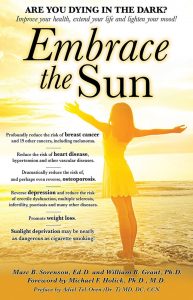
Mental illness: Vitamin D deficiency, and thereby sunlight deficiency, plays a major role. By Marc Sorenson, EdD.
Mental illness is a pandemic in the United States. Nearly one in five U.S. adults live with a mental illness (46.6 million in 2017). Mental illness has multiple causes and manifestations. It is especially relevant to understand that sunlight deprivation, leading to vitamin D deficiency, plays a major role in this disorder. It is also important to realize that sun exposure, for typical people, produces about 90% of serum (blood) vitamin D. In addition, this production occurs when midday sunlight touches the skin. However, vitamin D is only one of several photoproducts produced by sun exposure to skin or other body parts. In addition, sun exposure produces serotonin, endorphin, dopamine, and brain-derived neurotropic factor (BDNF). Furthermore, all of these vital chemicals has a profound influence on mental Illness.
An important study on vitamin D
The disease is ubiquitous, as is sun deprivation. Thus, thus an investigation on vitamin D and mental illness reminded me of the affects of sunlight. This laboratory-based study found a high prevalence of vitamin D deficiency among 290 patients with mental illness. Consequently, Only 18% of these patients showed adequate levels of vitamin D. To me, this also means that only 18% were obtaining sufficient sun exposure for good mental health and well-being. The researchers concluded that sensible sun exposure could be a boon to mental health.
Let us now discuss a few of the disorders classified as types of mental illness. Then we will also mention the research that indicates an impressive salutary influence of sun exposure.
ADHD, a mental illness of children
ADHD ( attention deficit hyperactivity disorder) is the most prevalent of all mental disorders in children. Hence, it causes significant problems with executive functions, leading to hyperactivity or impulsiveness not appropriate for the person’s age.
Researchers have found that sun exposure correlates to a decreased risk of ADHD. They assessed the relationship between the prevalence of ADHD and the intensity of the sun in various nations and in US states. And after adjusting for birth weights, infant mortality and other relevant factors, the findings were not altered. It was obvious that sun deprivation by itself was associated with a higher risk of ADHD.
Autism, another disease of youth
Is autism a sun-deficiency disorder? Autism rates are increasing exponentially and associate to vitamin D deficiency, which, of course, associates to sun deficiency. The Autism Society of America defines autism as “a complex developmental disability typically appearing during the first three years of life and is the result of a neurological disorder affecting the normal functioning of the brain, impacting development in the areas of social interaction and communication skills. Both children and adults with autism typically show difficulties in verbal and non-verbal communication, social interactions, and leisure or play activities.”
If vitamin D deficiency and/or sun deprivation relates to autism, symptoms should improve in summer. Thus, a case study reported by Dr. Cannell revealed improvements in autism-related sleep and behavioral problems during summer. Autistic traits such as crying, excitability, hyperactivity and pounding objects profoundly diminished during summer.
Bipolar Disorder
Bipolar disorder (BPD), also known as manic-depressive illness, is a brain disorder causing unusual shifts in mood, energy, activity levels, and the ability to perform day-to-day tasks. Symptoms are severe and can result in damaged relationships, poor job or school performance and even suicide.https://www.nimh.nih.gov/health/topics/bipolar-disorder/index.shtm
Sun exposure resets the body’s circadian rhythms, which are variations in physiology and behavior persistent with a cycle length close to 24 hours. This system is contained in the hypothalamus and stimulated by nerve cells in the retina of the eye in response to light. Research indicates that environmental conditions early in life may imprint the circadian system and influence mental function later in life: Increased number of hours of daylight at the location of birth during the first three months of life are associated with a significantly older age of onset of bipolar disorder. For a longer discussion on bipolar disorder, read the book, Embrace the Sun.
Cognitive disabilities (intellectual disorders)
Another research study, based on a 15-year residential history of varying degrees of sun exposure, produced an interesting result. It showed that cognitive impairment in persons who were below the median exposure to sunlight was 88% greater than in those who were above the median. These same investigators had previously shown that lower levels of sun exposure resulted in a 2.6-times higher incidence of cognitive impairment. Therefore, if you want to think clearly and keep your marbles, regularly soak up some non-burning sunlight.
Depression
Few people realize how prevalent depression is in our society, a mental illness representing a huge drain on the economy. Moreover, according to Steven Genuis, in an editorial in Canadian Family Physician, “The World Health Organization estimates depression costs the American economy about $44 billion annually, equal to the total cost of all cardiovascular diseases.” He also stated that in one decade, there was a 300% increase in the sales of antidepressants, making these medications the top-selling pharmaceuticals in the world. (Genuis, S. Keeping your sunny side up (editorial). Canadian Family Physician 2006:52:42-43.)
So what does the sun do to relieve “the blues?”
The answer probably lies in a chemical responsible for transmitting impulses between nerve cells. This “neurotransmitter,” serotonin, is a natural “upper,” and works in synchronization with the natural “downer,” melatonin. When we awake to sunshine, light enters the eye and stimulates serotonin production. We then quickly become awake and invigorated, and melatonin diminishes. Nevertheless, at day’s end, the bright light disappears (or at least it should), melatonin levels rise, and serotonin levels diminish. We begin to feel sleepy and ideally retire for a good night’s rest. It is a perfect system for our needs—unless we stay up beyond biologically natural hours, by using artificial lighting. Many experts believe that lack of serotonin is a cause of depression.
The most important study on serotonin
Though I mentioned this study in my previous blog on sunlight and depression, it bears repeating here. Dr. Gavin Lambert performed one of the most important and unique studies on serotonin. He and his colleagues measured serotonin levels in response to varying degrees of sunlight. First of all, they drew blood samples from the internal jugular veins of 101 men. In addition, they compared the serotonin concentrations of the blood to weather conditions and seasons. As a result, men measured on a bright day produced eight times more serotonin, than those measured on a dismal day. Of course, the mood improved due to sunlight, with no involvement whatsoever of vitamin D. Thus, regular, non-burning sun exposure is the answer to depression. In addition, remember that sun exposure also leads to the production of other mood enhancers such as nitric oxide, endorphin and dopamine.
Certainly, sunlight deprivation is not the only cause of mental illness, but it is one of the most important.
There are more mental illnesses to discuss, and I will expatiate on those in a future article. In the meantime, protect your mental health by being sure to obtain your share of non-burning sunlight. For more information, visit sunlightinstitute.org, and read the book, Embrace the Sun.
Depression, vitamin D and sunlight. Which is more important? By Marc Sorenson, EdD
Depression is a national horror made worse by fear, worry and lack of sunlight. The Covid-19 pandemic and the tendency to lock people away from sunlight and fresh air has taken an enormous toll.
Depression is more likely to respond to sunlight and vitamin D than sedentary living. That is the message I derived from a recent study. First, the purpose of the research was to estimate cumulative vitamin D doses in 96 depressed patients. These vitamin D doses came from two different sources: solar ultraviolet light, and dietary intake. Another part of the research was to compare vitamin D doses of these depressed patients to 96 age- and sex-matched healthy (non-depressed) controls.
Here are the “Enlightening” results and conclusions.
According to the researchers, there was the major (and probably unexpected) finding. Those with depression had significantly lower vitamin D doses compared to age- and sex-matched healthy controls. Thus, the research again proves the efficacy of sunlight (and possibly vitamin D) for reducing depression. Nevertheless, there was a more important conclusion as stated by the investigators. “While dietary intakes of vitamin D were equal in both groups, patients with depression appeared to have statistically significantly less vitamin D from solar ultraviolet B.” This statement is of transcendent importance due to the establishment of an important fact. That fact is that a superior form of vitamin D results from sun exposure.
Other points to remember regarding sunlight and depression.
In addition to this study, numerous other investigations corroborate the efficacy of sun exposure for ameliorating depression. Serotonin is a potent “upper” that improves mood almost immediately. Sunlight produces Serotonin when it enters the eyes.
The most impressive study on serotonin, sunlight and depression.
Dr. Gavin Lambert did one of the most important studies on serotonin. He and his colleagues measured serotonin levels in response to varying degrees of sunlight. To do so, they drew blood samples from the internal jugular veins of 101 men and compared the serotonin concentrations of the blood to weather conditions and seasons. The remarkable results: Men measured on a bright day produced eight times more serotonin, compared to those measured on a dismal day. Of course, the mood improved due to sunlight, with no involvement whatsoever of vitamin D. Thus, regular, non-burning sun exposure is the answer to depression. In addition, remember that sun exposure also leads to the production of other mood enhancers such as nitric oxide, endorphin and dopamine.
For more information regarding sunlight and depression, visit sunlightinstitute.org and read the book, Embrace the Sun.
Happy sunning!



